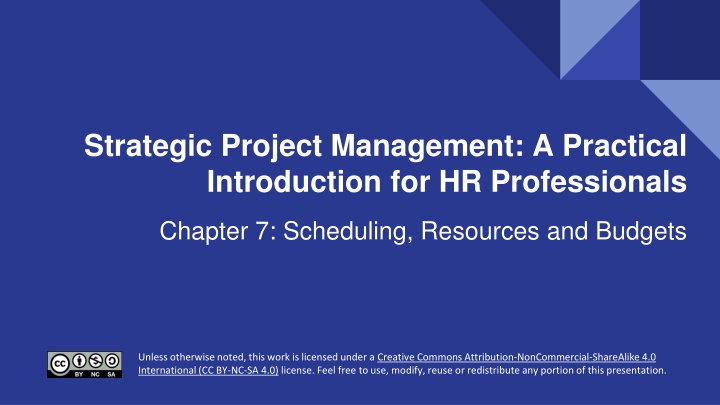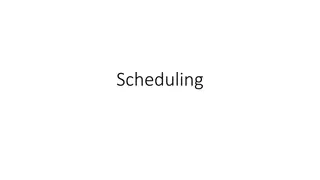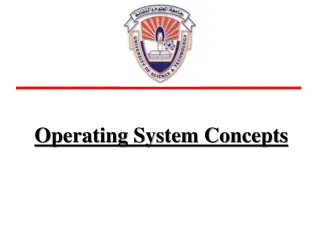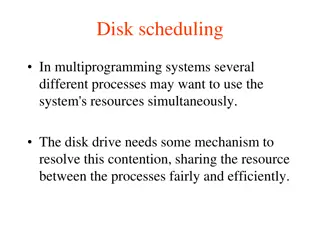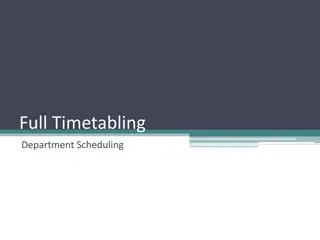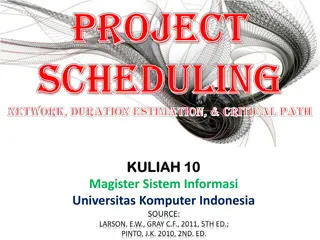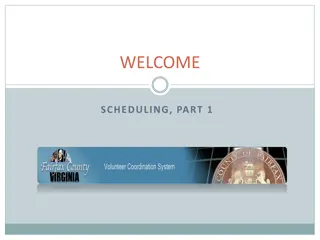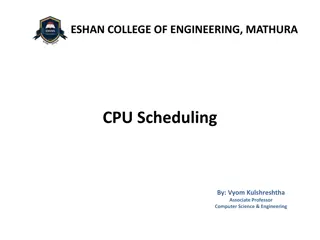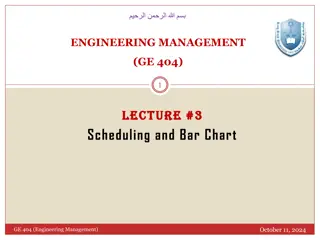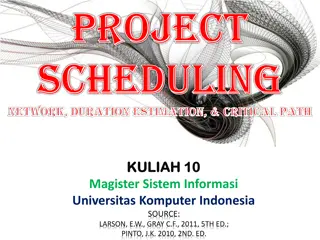Introduction to Project Management Scheduling & Resources
This chapter delves into the essential aspects of scheduling, resources, and budgets in project management for HR professionals. Explore topics like Work Breakdown Structures, resource constraints, cost estimation methods, and the significance of contingencies in project planning.
Download Presentation

Please find below an Image/Link to download the presentation.
The content on the website is provided AS IS for your information and personal use only. It may not be sold, licensed, or shared on other websites without obtaining consent from the author.If you encounter any issues during the download, it is possible that the publisher has removed the file from their server.
You are allowed to download the files provided on this website for personal or commercial use, subject to the condition that they are used lawfully. All files are the property of their respective owners.
The content on the website is provided AS IS for your information and personal use only. It may not be sold, licensed, or shared on other websites without obtaining consent from the author.
E N D
Presentation Transcript
Strategic Project Management: A Practical Introduction for HR Professionals Chapter 7: Scheduling, Resources and Budgets Creative Commons Attribution-NonCommercial-ShareAlike 4.0 International (CC BY-NC-SA 4.0) Creative Commons Attribution-NonCommercial-ShareAlike 4.0 International (CC BY-NC-SA 4.0) Unless otherwise noted, this work is licensed under a Creative Commons Attribution-NonCommercial-ShareAlike4.0 International (CC BY-NC-SA 4.0) license. Feel free to use, modify, reuse or redistribute any portion of this presentation.
7.1 Learning Objectives By the end of this chapter, you should be able to: 1. Define terms related to scheduling. 2. Demonstrate how cost and time are summarized in a WBS. 3. Demonstrate the process of decomposition and numbering used to create a WBS. 4. Explain the difference between a deliverable and work package. 5. Differentiate top-down estimation and bottom-up methods. 6. Define basic terms such as budget, estimate, price, cost, and value. 7. Discuss the relationship between cost and budget. 8. Explain basic concepts related to budgeting. 9. Identify different types of costs, and discuss issues related to contingency funds, profit, and cost estimating. 10.Explain the benefits of contingencies.
7.2 Scheduling Resources, Benefits, Constraints Resources are people, materials and equipment that come together to complete a project. Project Managers need to ensure all the resources required are available for the project. Constraints are when the resources are not available or limited. Project Managers need to balance the resources and constraints to ensure success. Once people, materials or equipment are placed on the schedule, it is important they are allocated as needed. Project managers use a classification of scheduling in two ways: Time- constrained resources and Resource-constrained.
7.3 Work Breakdown Structures The Work Breakdown Structure (WBS) is a hierarchical outline of all the deliverables involved in completing a project. The WBS is part of a project scope statement. The creation of a WBS is one of the first steps in organizing and scheduling the work for a project. Figure 7-1: The WBS is an outline that shows how the deliverables, sub- deliverables and work packages relate to the final project.
7.3 Deliverables vs. Work Packages Deliverables and sub-deliverables are things such as physical objects, software code, or events. In a WBS, deliverables and sub- deliverables are represented by nouns. Work packages are assignable units of work that will be performed to create the related deliverable. Work packages are action oriented and will be represented by phrases containing verbs.
7.3 WBS Numbering or Coding Project managers use the WBS during project execution to track the status of deliverables and work packages. The items in a WBS are numbered so it is easy to understand the deliverable, or sub-deliverable, to which any particular work package is related. Decomposition is the process used to break the project scope of work into the deliverables, sub-deliverables, and work packages involved in completing the project.
7.4 Defining Activities An activity is a process of further breakdown of the work package elements of the work breakdown structures (WBS) It documents the specific activities needed to fulfill the deliverables detailed in the Work Breakdown Structure (WBS) These activities are not the deliverables themselves but the individual units of work that must be completed to fulfill the deliverables.
7.5 Time Estimation Estimates have a huge influence on a project and are a large source of project risk. Helps with good decisions about approval Helps schedule the work Determines how long the project with take to complete Decide if it is worth doing the project Helps to decide how much money is needed for project Helps stakeholders know how well the project is moving forward
7.5 Top Down (Macro) Estimation Top-down, or macro, estimation methods allow for a quick estimate of project costs based on historical information. Analogous Estimating Parametric Estimating Learning Curves
7.5 Bottom Up (Micro) Estimations Bottom up, or micro, estimation techniques are used when the project is approved or is very likely to be approved. Bottom up estimates are more accurate, detailed and take more time to generate. Single Point Estimate Three Points Estimate
7.6 Managing the Schedule The project schedule is important as it serves as a baseline to measure time and costs. There are 2 common, visual methods to display schedules: The Gantt Chart The Network Diagram
7.6 The Gantt Chart A Gantt chart is a type of bar chart, developed by Henry Gantt, that illustrates a project schedule. These charts display the start and finish dates of the terminal elements and summary elements of a project Figure 7-5: Gantt Chart
7.6 The Network Diagram The network diagram is a way to visualize the interrelationships of project activities Figure 7-6: An example of an activity on node (AON) diagram
7.7 Estimating Resources Primary resources are people, equipment, and often, places, money, or anything else that you need in order to do all of the activities that you planned for. The goal of activity resource estimating is to assign resources to each activity in the activity list. Resource management is the efficient and effective deployment of an organization s resources when they are needed. One resource management technique is resource leveling.It aims at smoothing the stock of resources on hand, reducing both excess inventories and shortages.
7.8 Estimating Costs Types of costs: General/Admini strative Overhead Costs Indirect costs of running a business that supports the project ie. IT support Direct Project Overhead Costs Direct Costs Indirect Costs An expense traced directly to the project (product/service ) ie. Trainer s wages An expense not directly related to the project, yet costs of the project ie. Purchase of audio/visual equipment An expense tied to specific resources in the organization that are used in the project ie. Photocopier
7.8 Tools for Estimating Cost Determination of Resource Cost Rates Vendor Bid Analysis Reserve Analysis Cost of Quality
7.9 Understanding Budgets A budget is a decision made on the amount of money that will be spent on a project and how it will be spent. A Project Budget is a combination of all the activities milestones and tasks in the project. It is important to the project to: Secure the funding Financial viability in a direct way to the company Cost control can be maintained
7.10 Creating a Project Budget A simple budget can be created in 5 steps: Break project into small tasks and milestones Estimate each task and milestone Add the estimates all together Add in any contingencies/taxes/other costs Seek Approval
7.11 Contingency Funds In addition to creating the project plan, you need to create a contingency plan, which is a plan for addressing key possible obstacles to project success. A contingency plan typically includes a contingency fund, which is an amount of resources set aside to cover unanticipated costs. No matter how thoroughly you plan a project, you will inevitably miss at least a few small issues. A contingency fund is not designed to manage major deviations or scope changes.
7.12 Managing Budgets Project Manager manages the budget once approved Project Manager is responsible to monitor financial performance of the project and make financial decisions The budget is evaluated regularly as to whether the project is ahead, behind or on track with spending Reports are completed on actual spending within a certain period of time (monthly, quarterly, yearly) When a budget is overspent, the Project Manager needs to take corrective action
